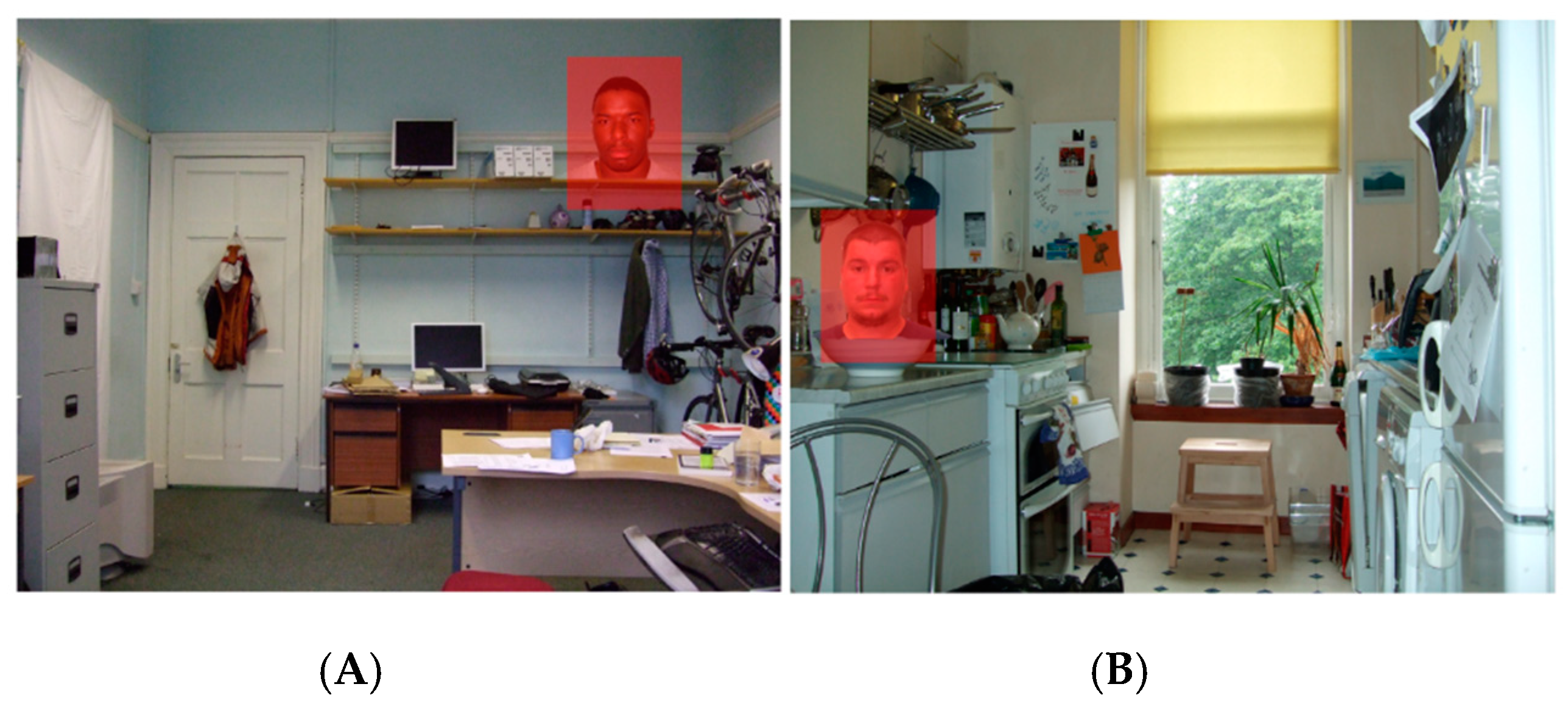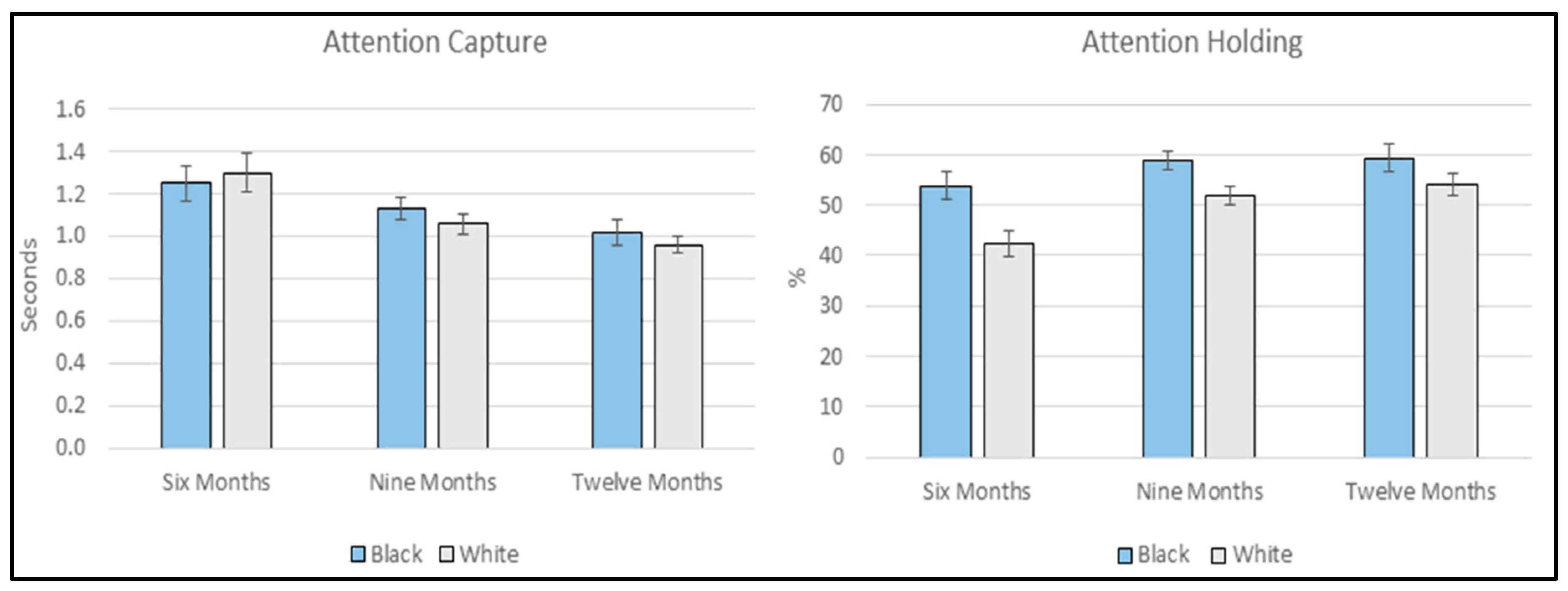Caucasian Infants’ Attentional Orienting to Own- and Other-Race Faces
Abstract
1. Introduction
2. Methods
2.1. Participants
2.2. Stimuli
2.3. Materials
2.4. Fixation and Saccade Parsing
2.5. Procedure
3. Results
3.1. Attention Capture
3.2. Attention Holding
3.3. Face Detection
3.4. Face Detection Saccadic Latency
3.5. Image Analysis: Face Location
3.6. Image Analysis: Visual Saliency
4. Discussion
5. Conclusions
Supplementary Materials
Author Contributions
Funding
Acknowledgments
Conflicts of Interest
References
- Haxby, J.V.; Hoffman, E.A.; Gobbini, M.I. The distributed human neural system for face perception [Record Supplied By Publisher]. Trends Cogn. Sci. 2000, 4, 223–233. [Google Scholar] [CrossRef]
- Crouzet, S.M.; Kirchner, H.; Thorpe, S.J. Fast saccades toward faces: Face detection in just 100 ms. J. Vis. 2010, 10, 16. [Google Scholar] [CrossRef] [PubMed]
- Johnson, M.H.; Dziurawiec, S.; Ellis, H.; Morton, J. Newborns’ preferential tracking of face-like stimuli and its subsequent decline. Cognition 1991, 40, 1–19. [Google Scholar] [CrossRef]
- Turati, C.; Valenza, E.; Leo, I.; Simion, F. Three-month-olds’ visual preference for faces and its underlying visual processing mechanisms. J. Exp. Child Psychol. 2005, 90, 255–273. [Google Scholar] [CrossRef] [PubMed]
- Farroni, T.; Johnson, M.H.; Menon, E.; Zulian, L.; Faraguna, D.; Csibra, G. Newborns’ preference for face-relevant stimuli: Effects of contrast polarity. Proc. Natl. Acad. Sci. USA 2005, 102, 17245–17250. [Google Scholar] [CrossRef] [PubMed]
- Valenza, E.; Simion, F.; Cassia, V.M.; Umiltà, C. Face Preference at Birth. J. Exp. Psychol. Hum. Percept. Perform. 1996, 22, 892–903. [Google Scholar] [CrossRef]
- Reid, V.M.; Dunn, K.; Young, R.J.; Amu, J.; Donovan, T.; Reissland, N. The Human Fetus Preferentially Engages with Face-like Visual Stimuli. Curr. Biol. 2017, 27, 1825–1828. [Google Scholar] [CrossRef]
- Scheel, A.M.; Ritchie, S.J.; Brown, N.J.L.; Jacques, S.L. Methodological problems in a study of fetal visual perception. Curr. Biol. 2018, 28, R594–R596. [Google Scholar] [CrossRef]
- Johnson, M.H.; Senju, A.; Tomalski, P. The two-process theory of face processing: Modifications based on two decades of data from infants and adults. Neurosci. Biobehav. Rev. 2015, 50, 169–179. [Google Scholar] [CrossRef]
- Johnson, M.H. Subcortical face processing. Nat. Rev. Neurosci. 2005, 6, 766–774. [Google Scholar] [CrossRef]
- Leppänen, J.M. Using Eye Tracking to Understand Infants’ Attentional Bias for Faces. Child Dev. Perspect. 2016, 10, 161–165. [Google Scholar] [CrossRef] [PubMed]
- Elsabbagh, M.; Gliga, T.; Pickles, A.; Hudry, K.; Charman, T.; Johnson, M.H. The development of face orienting mechanisms in infants at-risk for autism. Behav. Brain Res. 2013, 251, 147–154. [Google Scholar] [CrossRef] [PubMed]
- Gliga, T.; Elsabbagh, M.; Andravizou, A.; Johnson, M.H. Faces attract infants’ attention in complex displays. Infancy 2009, 14, 550–562. [Google Scholar] [CrossRef]
- Gluckman, M.; Johnson, S.P. Attentional capture by social stimuli in young infants. Front. Psychol. 2013, 4, 527. [Google Scholar] [CrossRef] [PubMed]
- Di Giorgio, E.; Turati, C.; Altoè, G.; Simion, F. Face detection in complex visual displays: An eye-tracking study with 3- and 6-month-old infants and adults. J. Exp. Child Psychol. 2012, 113, 66–77. [Google Scholar] [CrossRef]
- Jakobsen, K.V.; Umstead, L.; Simpson, E.A. Efficient human face detection in infancy. Dev. Psychobiol. 2016, 58, 129–136. [Google Scholar] [CrossRef]
- Amso, D.; Haas, S.; Markant, J. An eye tracking investigation of developmental change in bottom-up attention orienting to faces in cluttered natural scenes. PLoS ONE 2014, 9, 1–7. [Google Scholar] [CrossRef]
- Frank, M.C.; Amso, D.; Johnson, S.P. Visual search and attention to faces during early infancy. J. Exp. Child Psychol. 2014, 118, 13–26. [Google Scholar] [CrossRef]
- Kelly, D.J.; Duarte, S.; Meary, D.; Bindemann, M.; Pascalis, O. Infants rapidly detect human faces in complex naturalistic visual scenes. Dev. Sci. 2019. [Google Scholar] [CrossRef]
- Quinn, P.C.; Lee, K.; Pascalis, O. Face Processing in Infancy and Beyond: The Case of Social Categories. Annu. Rev. Psychol. 2019, 70, 165–189. [Google Scholar] [CrossRef]
- Kelly, D.J.; Quinn, P.C.; Slater, A.M.; Lee, K.; Gibson, A.; Smith, M.; Ge, L.; Pascalis, O. Three-month-olds, but not newborns, prefer own-race faces. Dev. Sci. 2005, 8, 31–36. [Google Scholar] [CrossRef] [PubMed]
- Pascalis, O.; Kelly, D.J. The origins of face processing in humans: Phylogeny and ontogeny. Perspect. Psychol. Sci. 2009, 4, 200–209. [Google Scholar] [CrossRef] [PubMed]
- Bar-Haim, Y.; Ziv, T.; Lamy, D.; Hodes, R.M. Nature and Nurture in Own-Race Face Processing. Psychol. Sci. 2006, 17, 159–163. [Google Scholar] [CrossRef] [PubMed]
- Kelly, D.J.; Liu, S.; Ge, L.; Quinn, P.C.; Slater, A.M.; Lee, K.; Liu, Q.; Pascalis, O. Cross-race preferences for same-race faces extend beyond the African versus Caucasian contrast in 3-month-old infants. Infancy 2007, 11, 87–95. [Google Scholar] [CrossRef] [PubMed]
- Anzures, G.; Quinn, P.C.; Pascalis, O.; Slater, A.M.; Lee, K. Categorization, categorical perception, and asymmetry in infants’ representation of face race. Dev. Sci. 2010, 13, 553–564. [Google Scholar] [CrossRef]
- Bindemann, M.; Burton, A.M. The role of color in human face detection. Cogn. Sci. 2009, 33, 1144–1156. [Google Scholar] [CrossRef]
- Bindemann, M.; Scheepers, C.; Ferguson, H.J.; Burton, A.M. Face, Body, and Center of Gravity Mediate Person Detection in Natural Scenes. J. Exp. Psychol. Hum. Percept. Perform. 2010, 36, 1477–1485. [Google Scholar] [CrossRef]
- Birmingham, E.; Bischof, W.F.; Kingstone, A. Get real! Resolving the debate about equivalent social stimuli. Vis. Cogn. 2009, 17, 904–924. [Google Scholar] [CrossRef]
- Fassbender, I.; Teubert, M.; Lohaus, A. The development of preferences for own-race versus other-race faces in 3-, 6-and 9-month-old Caucasian infants. Eur. J. Dev. Psychol. 2016, 13, 152–165. [Google Scholar] [CrossRef]
- Fysh, M.C. Individual differences in the detection, matching and memory of faces. Cogn. Res. Princ. Implic. 2018, 3. [Google Scholar] [CrossRef]
- Hayden, A.; Bhatt, R.S.; Zieber, N.; Kangas, A. Race-based perceptual asymmetries underlying face processing in infancy. Psychon. Bull. Rev. 2009, 16, 270–275. [Google Scholar] [CrossRef] [PubMed]
- Holmqvist, K.; Nyström, M.; Mulvey, F. Eye tracker data quality: What it is and how to measure it. Proc. Symp. Eye Track. Res. Appl. 2012, 45–52. [Google Scholar] [CrossRef]
- Kelly, D.J.; Liu, S.; Lee, K.; Quinn, P.C.; Pascalis, O.; Slater, A.M.; Ge, L. Development of the other-race effect during infancy: Evidence toward universality? J. Exp. Child Psychol. 2009, 104, 105–114. [Google Scholar] [CrossRef] [PubMed]
- Kelly, D.J.; Quinn, P.C.; Slater, A.M.; Lee, K.; Ge, L.; Pascalis, O. The other-race effect develops during infancy: Evidence of perceptual narrowing. Psychol. Sci. 2007, 18, 1084–1089. [Google Scholar] [CrossRef]
- Sugden, N.A.; Marquis, A.R. Meta-Analytic Review of the Development of Face Discrimination in Infancy: Face Race, Face Gender, Infant Age, and Methodology Moderate Face Discrimination. Psychol. Bull. 2017, 143, 1201–1244. [Google Scholar] [CrossRef]
- Quinn, P.C.; Lee, K.; Pascalis, O.; Tanaka, J.W. Narrowing in categorical responding to other-race face classes by infants. Dev. Sci. 2016, 19, 362–371. [Google Scholar] [CrossRef]
- Liu, S.; Xiao, W.S.; Xiao, N.G.; Quinn, P.C.; Zhang, Y.; Chen, H.; Ge, L.; Pascalis, O.; Lee, K. Development of visual preference for own-versus other-race faces in infancy. Dev. Psychol. 2015, 51, 500–511. [Google Scholar] [CrossRef]
- Singarajah, A.; Chanley, J.; Gutierrez, Y.; Cordon, Y.; Nguyen, B.; Burakowski, L.; Johnson, S.P. Infant attention to same- and other-race faces. Cognition 2017, 159, 76–84. [Google Scholar] [CrossRef]
- Levin, D.T. Classifying faces by race: The structure of face categories. J. Exp. Psychol. Learn. Mem. Cogn. 1996, 22, 1364–1382. [Google Scholar] [CrossRef]
- Minear, M.; Park, D.C. A lifespan database of adult facial stimuli. Behav. Res. Methods Instrum. Comput. 2004, 36, 630–633. [Google Scholar] [CrossRef]
- Walther, D.; Koch, C. Modeling attention to salient proto-objects. Neural Netw. 2006, 19, 1395–1407. [Google Scholar] [CrossRef] [PubMed]
- Peltola, M.J.; Hietanen, J.K.; Forssman, L.; Leppänen, J.M. The emergence and stability of the attentional bias to fearful faces in infancy. Infancy 2013, 18, 905–926. [Google Scholar] [CrossRef]
- Office for National Statistics. 2011 Census: Cultural Diversity in Kent; UK Data Service: Colchester, UK, 2011. [CrossRef]



| Attention Orienting | Detection | ‘First look’ i.e., the percentage of trials in which the infant’s first saccade is directed to a face AOI. |
| Capture | ‘Orienting speed’ i.e., the mean time taken to orient toward a face AOI following stimulus onset—not necessarily first fixation | |
| Attention Holding | ‘Face fixation duration’ i.e., the mean percentage of total stimulus looking time spent on a face AOI once it has been fixated | |
| 6 months (n = 50) | 9 months (n = 73) | 12 months (n = 49) |
|---|---|---|
| M = 184.5 range = 178–193 female = 23 | M = 275.1 range = 268–282 female = 37 | M = 368.2 range = 361–374 female = 29 |
© 2020 by the authors. Licensee MDPI, Basel, Switzerland. This article is an open access article distributed under the terms and conditions of the Creative Commons Attribution (CC BY) license (http://creativecommons.org/licenses/by/4.0/).
Share and Cite
Prunty, J.E.; Jackson, K.C.; Keemink, J.R.; Kelly, D.J. Caucasian Infants’ Attentional Orienting to Own- and Other-Race Faces. Brain Sci. 2020, 10, 53. https://doi.org/10.3390/brainsci10010053
Prunty JE, Jackson KC, Keemink JR, Kelly DJ. Caucasian Infants’ Attentional Orienting to Own- and Other-Race Faces. Brain Sciences. 2020; 10(1):53. https://doi.org/10.3390/brainsci10010053
Chicago/Turabian StylePrunty, Jonathan E., Kelsey C. Jackson, Jolie. R. Keemink, and David J. Kelly. 2020. "Caucasian Infants’ Attentional Orienting to Own- and Other-Race Faces" Brain Sciences 10, no. 1: 53. https://doi.org/10.3390/brainsci10010053
APA StylePrunty, J. E., Jackson, K. C., Keemink, J. R., & Kelly, D. J. (2020). Caucasian Infants’ Attentional Orienting to Own- and Other-Race Faces. Brain Sciences, 10(1), 53. https://doi.org/10.3390/brainsci10010053





